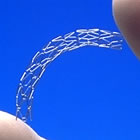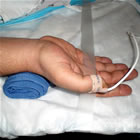
|
Is This Angiogram / Angioplasty Necessary?
|
|
||||||||||||
|
Current Postings on This Page (8):
• I have a coronary angiogram booked in three weeks. This was advised because I get chest pain on walking (typically after, say, 500 metres), which ceases within a couple of minutes when I stop walking- a classic angina symptom. However, when I press on the chest wall on the left, there is always an area which is sore and tender to the touch; this is associated with costochondritis (or chest wall inflammation). The two symptoms-pain on exertion and pain on palpation- are treated as if they are mutually exclusive in the medical articles I have read. Is it possible that if you have angina it could also cause pain on palpation? Following from this question, is it a good decision to have an angiogram for this combination of symptoms given that it is potentially very unpleasant procedure? • Tom -- sorry you're confused -- hopefully
it's not because of our articles, but because there has been much confusion
around the results of the COURAGE trial. OK. Number one. A blockage
does not necessarily mean you're at risk for a heart attack. It is
currently believed that heart attacks are caused by "vulnerable plaque",
a coronary artery plaque that ruptures releasing all kinds of thrombus-inducing
material into the blood stream, causing clots, and subsequent blockage
of blood flow. These plaques are not necessarily large ones that would
be seen
on angiography. However, they CAN be seen using other techniques,
such as intravascular ultrasound (IVUS). The question on whether opening
up any blockage is always, "Is it obstructive?" That is, does it reduce
blood flow to the point that (1) it causes angina; or (2) it is so
narrow, and in a major artery, that any small clot could cause a major
event. To answer your question, all these trials and studies try to
point to what could be called "best practice". What the COURAGE trial
DID show was that stenting could be safely deferred in the patient
population covered by the COURAGE trial -- namely low risk patients
with stable angina. Other types of patients, such as the scenario you
describe, cannot be automatically included. • After reading Angioplasty.Org's articles
commenting on the "COURAGE" TRIAL", I am little confused. What about
this scenario: An individual is currently experiencing NO angina or
other symptoms, but since routine tests are questionable, a subsequent
angiogram reveals previous double-bypass done four years ago has failed
(closed), and patient is back where he started from with 80% blockages
involving the distal
left main & the ostium of the left circumflex artery & the left anterior descending
artery (but, as I said, with No current angina). Are we to conclude that since
this time there is no angina or other symptoms, that rather then using stents
or attempting another bypass that the patient should initially treat this with
medications only? And if so, is not the patient risking a sudden massive heart
attack during this treatment, since blockages in those
areas are rather serious? • Jay -- read the articles listed in the right-column
side-bar. They talk about the COURAGE trial which showed that angioplasty
and/or stenting did not prolong life or prevent heart attacks in patients
with stable angina and relatively low risk blockages. Stents did, however,
reduce angina (chest pain) and improve exercise tolerance better than
drugs alone -- which is really why angioplasty is used. There has
never been a study demonstrating
that
stents or angioplasty prolong life or prevent heart attacks better
than drugs. We recommend that you inform yourself and then discuss
these issues with
your cardiologist. Many
have warned against the oculo-stenotic reflex -- where cardiologists
do
diagnostic catheterizations and, if they see a blockage
(a.k.a. stenosis), they unblock
it in the same session. There are plusses and minues to this approach,
also called "ad hoc angioplasty". The plusses? The patient
doesn't need to undergo a second catheterization. The complication
rate for
catheterization is somewhere between 3-6%, mostly
around the femoral artery
entry point. So by doing everything in the same session you minimize
the complications. Also the cost is reduced. The minuses?
You eliminate a less invasive option, which is trying medical therapy
to alleviate the
symptoms
and going
back with
a stent
only if that
doesn't work. All of this is a complicated issue. Our advice
is to discuss these concerns with your interventional cardiologist
BEFORE
getting
into the cath lab -- decide together what the best course of action
is, and then proceed in confidence and understanding that you are doing
the right thing. You might also ask whether a 64 slice CT scan might
be a less invasive diagnostic first step. Again, your cardiologist
may have very specific and very good reasons for stenting. And there's
no problem asking what they are. • Thank you for your web-site and its wealth
of information. I am 49 y/o man, active with no symptoms of heart
disease. I have mild hypertension and a family history of heart disease.
Last
week I had a stress test at my first-ever visit to a cardiologist.
They suggested angiogram immediately, and informed me if they found
blockages, they would treat then-and-there with angioplasty and stents.
I am concerned about doing too much too quickly. Are there alternative
treatments to using stents? • VL -- 70% blockage is what the very provocative
COURAGE trial just looked at, and found that in low risk patients with
stable angina, there was no difference in survival or incidence of
heart attack between those who had optimal medical therapy or those
who also had a stent placed. The take-away from the study was that
for those patients, there was no "emergency" to have a stent
placed. Of course, you need to discuss with your cardiologist if you
are part of the patient population studied in the COURAGE trial --
or at higher risk. • I have a 70% blockage of right anterior artery,
diagnosed by angioplasty, 65% EF, just became 78yrs, female. Dr. says
I must have stent or heart attack. Scheduled for Apr. 19, but wonder
why there is such a hurry. I have a cat scan coming up in June to check
for metastasis and am concerned about being on plavix if surgery is
needed. I am asymptomatic and would like to delay stenting. Am I being
unrealistic? |
|||||||||||||






